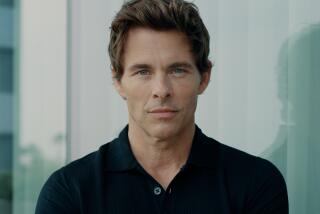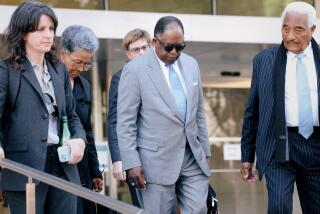Jury Order Deals a Blow to Andersen
- Share via
HOUSTON — In a pivotal decision, U.S. District Judge Melinda Harmon ruled Friday that jurors could convict Arthur Andersen of obstruction of justice even if they disagree on which of the firm’s executives violated the law.
The ruling--which had been sought by prosecutors--could allow jurors to break their deadlock in the six-week trial of the accounting firm. Harmon acknowledged struggling to reach the decision, saying the lack of case law in the area put her in the “terrifying” position of ruling in uncharted legal territory.
Shortly afterward, Andersen lead attorney Rusty Hardin asked Harmon to declare a mistrial, saying the new instruction, coupled with the length of the jury deliberations, could be seen as coercing jurors to reach a verdict. Harmon denied the motion.
After receiving Harmon’s decision, the jurors deliberated for about 45 minutes without reaching a verdict and returned to a hotel where they have been sequestered since last week. The panel of nine men and three women is to begin its 10th day of deliberations today.
Andersen is charged with destroying Enron Corp.-related documents with the intent of undermining a Securities and Exchange Commission inquiry of the failing energy trader.
To convict the firm, prosecutors have to prove beyond a reasonable doubt that one or more Andersen executives “corruptly persuaded” someone to withhold or destroy records in order to keep them away from the SEC.
Jurors had asked, in a note to the judge Thursday, whether they had to agree on which executive may have acted corruptly. Prosecutors praised the ruling, but Andersen attorneys contended that jurors must unanimously agree on which person had corrupt intent.
Calling the ruling “utterly unsupportable,” Andersen lawyer Charles Rothfeld said the judge delivered a significant new instruction to a jury that had already declared an impasse. That, he said, amounts to coercing the jury toward a decision.
Laurie Levenson, a Loyola Law School professor, called the decision the “worst news for defense counsel.”
“Obviously, if there is a conviction, it will be a major point for appeal,” she said. “But it doesn’t mean [the judge] was wrong. It’s just a cutting-edge issue. The court of appeals will get the last word on it.”
Harmon’s decision came several hours after the two sides made last-ditch arguments over their interpretations of relevant precedents.
Andersen attorney Denis McInerney said federal courts have held that juries can reach a verdict without agreeing on certain facts only when those facts are “peripheral or trivial.” In contrast, he said, the question of which executive had criminal intent is “the most important aspect of our trial.”
McInerney said Hardin’s closing argument--which focused on refuting the idea that either Enron audit team leader David B. Duncan or Andersen staff counsel Nancy Temple had criminal intent--would have been “radically different” if Andersen believed the court would instruct jurors that they didn’t have to identify a specific executive.
But Assistant U.S. Atty. Andrew Weissmann said that if juries always had to agree on which individual within a corporation committed an offense, “the loophole [in] corporate criminal liability
Weissmann also told Harmon that “if there is any sort of default position” on how to decide the issue, it should favor the Justice Department because “we don’t get a right to appeal” but the defense does.
After reviewing the arguments and case law in chambers, Harmon emerged to say “not one of the cases is directly on point.” She told those in the courtroom that “if someone knows of a case ... I would really urge you to give me the [citation] right now so I don’t make a mistake and rule incorrectly.”
After Harmon announced her decision, Andersen attorneys asked the judge to order the jury to fill out a special verdict form if they reach a decision, in which jurors would have to say whether they agreed unanimously on which executives violated the law and also identify the executives.
Harmon said she did not believe it was necessary to poll the panel but indicated that she might be open to other specialized questions.
Andersen counsel also asked Harmon to reopen closing arguments. The judge denied the request.
Some lawyers said the ruling was potentially troubling for other corporations and partnerships.
“In essence, each juror can disagree as to what the other 11 believe about a given employee,” said Tom Holliday, a partner and criminal defense lawyer for Gibson, Dunn & Crutcher in Los Angeles. “But if each juror has their own culpable employee, the instruction would appear to lead to a verdict. And that strikes me as unfair and maybe unconstitutional.”
Harmon’s ruling on the jury’s question was the second blow for Andersen in a dispute over the way the jurors were instructed.
Earlier in the week, Hardin objected to the special instruction known as an Allen charge that Harmon gave jurors after they declared a deadlock on Wednesday, asking the panel to renew efforts to reach a verdict.
Although the instructions were taken almost verbatim from a model charge used within the federal circuit, Andersen’s lawyers opposed Harmon’s decision to cut a line that reminds jurors they should return a not-guilty verdict “if the evidence in the case fails to establish guilt beyond a reasonable doubt.”
*
Times staff writer Lisa Girion contributed to this report.
More to Read
Inside the business of entertainment
The Wide Shot brings you news, analysis and insights on everything from streaming wars to production — and what it all means for the future.
You may occasionally receive promotional content from the Los Angeles Times.










